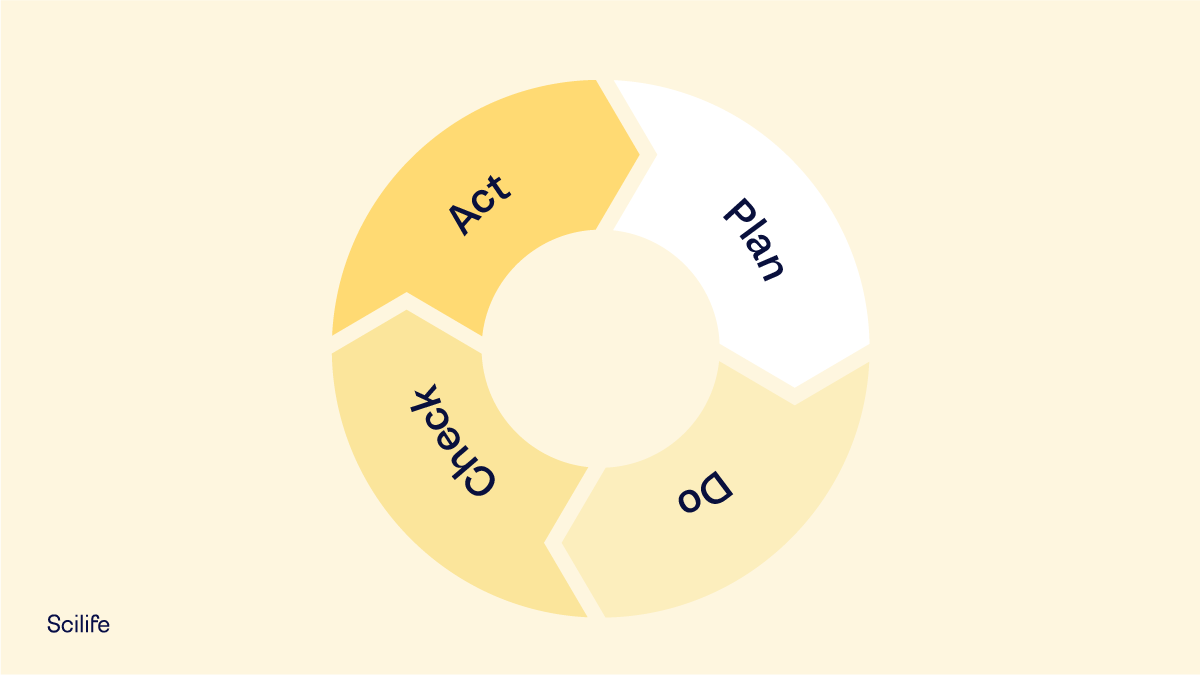
In the highly regulated pharmaceutical and medical device industries an electronic Quality Management System plays a pivotal role where you can create, store, retrieve, and archive all of your company’s quality-related documents. Those activities ensure compliance with stringent regulations and enhance operational efficiency and product quality. Today, we’ll guide you through the essential steps of a successful transition, outlining best practices and strategic considerations that mitigate risks and capitalize on the benefits of a modern eQMS.
Medical device manufacturers face many market challenges and pressures, including fast-changing and growing complex regulatory environments, an increase in risk and cost of compliance, higher demand for innovation and fast delivery of products, and increasing complexity of product portfolio and supply chain processes.
To remain competitive in the dynamic and demanding medical device market, manufacturers should invest in eQMS software and incorporate new capabilities to increase its operational agility and effectiveness, while driving continuous improvement, maintaining a grip on compliance, improving product quality, fostering innovation, and increasing customer satisfaction. Furthermore, QMS would offer benefits that go well beyond mere compliance, by emphasizing more on innovation, patient safety, sustainability, and data-driven decision-making.
Things to consider before transitioning to another eQMS
It's crucial to conduct a thorough assessment of the existing QMS before moving to the new eQMS. This will:
- highlight what improvements are needed and what should be retained.
- provide a clear roadmap for the transition and bring more visibility and control.
- help you to understand the architecture of your current system, including its strengths and shortcomings.
- evaluate your organizational culture to ensure it supports a seamless transition, focusing on quality processes that engage every department.
- assessing readiness involves determining if your staff is prepared for change and if your organizational processes are adaptable to new technologies.
Enterprise quality management systems support compliance with increasingly stringent regulations aimed at improving drug and device quality and safety. Let’s learn what factors to consider before making massive moves from one system to another:
- Compatibility: This is critical for data collection. It either needs to have an API to talk to the systems you use or natively integrate into those systems like Salesforce or other CRMs.
- Regulatory compliance: This is critical, especially in sectors like medical devices, life sciences, manufacturing, etc. The new QMS should meet industry-specific regulatory requirements.
- Vendor support and capabilities: Evaluate the QMS vendor's support and resources.
- Cost: Consider both the upfront and long-term costs of the new eQMS system.
- Security: Ensure the new system has robust data security and privacy measures.
- Scalability: Ensure the system can grow with your business needs.
In light of all these challenges, it makes sense to switch from one eQMS to another. Are you planning to switch from one eQMS to another? Read on to discover how to overcome these challenges.
How to plan your transition
Define Your Project Goals
Start by clearly defining the transition scope and objectives in advance. Specify the critical targets including the desired go-live date, budget constraints, and key improvements expected after the new eQMS implementation (e.g., enhanced data analytics, improved user interface, integration capabilities with other systems). These objectives help your employees align their goals with your company’s QMS goals.
Conduct a System Audit of the Existing eQMS
In today's eQMS solutions, workflows are fully automated, end-to-end visibility is provided, and quality-related processes can be controlled from one location. Digital platforms should replace outdated, clunky processes rather than reimplementing them. To speed up decision-making, it should simplify quality oversight and provide timely, accurate, and actionable analytics.
The transition from an eQMS to a modern one is an opportunity to improve and advance. Therefore, you should evaluate your current quality management processes and determine what works/doesn’t work well for your quality team, leadership, and other stakeholders. Understanding the capabilities and limitations of your current eQMS is crucial. Perform a comprehensive audit to review the complete structure behind your existing QMS including data integrity, user satisfaction, and integration with other systems. This step will identify what features should be retained, what needs improvement, and any data cleanup required before migration.
Assemble a Transition Team
The transition from one eQMS to another is not one man’s job. You need to team up a dedicated transition team with at least one member from each business function/department including IT, regulatory affairs, and quality management. Team members should have a clear role, with responsibilities ranging from technical support to training and change management. Additionally, they should collaborate with the remaining employees in each department/ business function to facilitate a smooth transition.
Set Timelines
Once the objectives and the transition are settled, you can discuss the overall timeline for the transition. You can also discuss the expected date when the new eQMS system will be in place. Normally the implementation process can take anywhere from 30 days to 12 months. This period can be determined by the type of eQMS software. Some vendors like Scilife offer a pre-validated software solution, lifting 99% of the validation burden so you don't have to worry about validating the software. However, if you need a more customized solution, it requires revalidation and will take longer to develop and deploy than one that is pre-validated.
Streamline Processes and Data
Before migrating to the new system, streamline existing processes and data. Identify and eliminate duplicate, redundant, or outdated processes and documents to optimize the process. Once all processes and documents are streamlined, consolidate only relevant, accurate information. This simplification will reduce complexity during migration and improve system performance post-transition. At this stage, you can consider the number of employees who will need access to the eQMS. You can also define their access levels based on their roles and responsibilities within the organization.
Plan the data migration
A streamlined QMS structure will give you the confidence to begin data migration. It is easier to complete the data migration if your eQMS partner is Scilife. All you need to do is populate a spreadsheet with your documents' metadata and share their corresponding files. Our Customer Success team will guide you through this process.
Alternatively, you can develop a detailed data migration plan that includes data mapping, validation, and testing. Since both old and new systems are electronic, ensure data formats and structures integrity and compatibility. Work closely with the new eQMS vendor to understand specific requirements to transfer data securely and accurately. In addition, understand any tools that automate part of this process.
Additionally, before the data migration ensure that you have a risk management plan in place.
Manage the change
To successfully manage a transition you should develop a strategy for managing change and addressing resistance to change within the organization. The transition to an eQMS may seem like a job for Quality, but it affects all functions within the company. As a change owner, you should involve all functions in the change process. You should ask what capabilities and functionalities are most critical to them, and develop a plan covering quality and other functions. Ensure to provide training sessions with ongoing support to keep everyone moving in the same direction to meet change objectives.
Configure the new eQMS
eQMS systems are typically designed for the pharmaceutical and medical device industries. However, you may have additional needs. You can configure basic settings such as workflows, user permissions, and integrations with other systems. The configuration should be guided by streamlined processes and leverage the advanced features of the new system to enhance functionality. For the transition between systems ensure that the existing configurations are still available for the new eQMS. If not, assess the risks and benefits of the new configurations.
Train your teams
Assess the organization's training needs to use the new system effectively. The training program should cover concerns such as:
- What is the switchover date?
- Do the systems intend to run in parallel for a while?
- What are the roles and responsibilities of each team member?
- What resources are available?
- How will the team be held accountable for a successful transition?
- Is the old system available during the new system transition?
Implement a comprehensive training program that addresses both the technical and functional aspects of the new eQMS. The train-the-trainer concept works well for big organizations. Therefore, in big organizations, you will need to train your team members first. Later they will train their respective teams. This method facilitates deeper understanding and knowledge transfer. In smaller organizations, everyone can be trained at the same time.
Pilot testing
Conduct pilot testing with a select group of users to validate the functionality and integration of the new eQMS. This phase should uncover any issues in real-world scenarios, allowing for adjustments before full-scale implementation.
Go live
Once the pilot succeeds, the eQMS can go live. You can plan a phased rollout or a full go-live, depending on your organization's size and readiness. Ensure all users are adequately trained, and support structures are in place. An eQMS that uses the cloud, such as Scilife, won't take up much time since users don't need to install anything. You can quickly create the required users and their access levels. Additionally, we will collaborate with your IT team to work on features like Single sign-on. Therefore, if you are working with us, be assured that your transition to Scilife eQMS will be super smooth.
Post-Implementation Review and Optimization
After going live, continuously monitor the system performance and user feedback. Identify any areas for improvement and work on optimizing the system. Regular updates and training should be planned to ensure the system evolves with organizational needs and technological advancements.

POTI: An approach to transforming eQMS
Medical device manufacturers' eQMS should be future-proofed to navigate shifting regulations and market landscapes easily. The POTI model—standing for People, Organization, Technology, Information—helps tackle this change efficiently, especially during the transition to a new eQMS. Using this approach, it is possible to assess the current situation, identify risks and improvement opportunities, and formulate a roadmap for integrating desired changes. An engaging and detailed explanation of each POTI component follows:
People
Any new system's success hinges on the people who use it. In the context of the eQMS transition, "People" refers to the entire gamut of stakeholders, from the C-level to floor staff.
- Engagement: It is essential to consider and engage all stakeholders. This involves understanding their needs and addressing their concerns.
- Training: Empowering “People” with the right tools and training. Focus on comprehensive training programs.
- Culture of Change: Establish a culture that embraces change, promotes open communication, and converts resistance into enthusiasm.
- Communication Plans: Promote clear communication about the new eQMS benefits and changes.
- Feedback Mechanisms: Consider facilitating interactive workshops and real-time feedback sessions that train your team, while also addressing concerns, gathering feedback, and empowering them to make change happen.
Organization
The "Organization" element focuses on aligning the structural, procedural, and cultural frameworks to support the new eQMS.
- Structural Alignment: Review and redefine roles and responsibilities to align the organizational structure with the new eQMS.
- Process Optimization: Create a structure that provides operational efficiency and compliance as well as simplifies and optimizes processes based on risk.
- Cultural Adaptation: Promote quality and continuous improvement within the organization to ensure successful eQMS integration.
- Policy Updates: Organize a series of strategy sessions in which leaders reimagine workflows that fit the new system but also optimize it.
Technology
In the transition to a new eQMS, "Technology" plays a pivotal role as the actual tool that will carry your quality management into the future.
- System Selection: Choose a system that meets current needs and adapts to future changes.
- Integration Capabilities: Ensure the new eQMS integrates seamlessly with the existing IT infrastructure.
- User-Friendly Interface: Establish a user-friendly interface for the eQMS to encourage adoption.
- Maintenance and Support: When choosing a vendor, consider factors like customization capabilities and technical support.
Also, identify automation opportunities for simple or error-prone repetitive tasks. A QMS-validated solution supports decision-making, automates manual tasks, identifies trends, and returns value.
Information
"Information" is crucial for making informed decisions and ensuring continuous process improvement. This component focuses on how data is managed, protected, and utilized within the new eQMS.
- Data Migration: Ensure data integrity and seamless migration by managing and protecting data meticulously.
- Decision Support: Use advanced analytics to transform data into strategic insights for fast and informed decision-making.
- Access Controls: Enhance security and protect against data breaches by implementing robust access control measures.
- Compliance Assurance: Ensure all data handling and storage practices meet industry standards and legal requirements.
- Data Utilization: Ensure all data is accurate, relevant, and timely to improve quality, efficiency, and effectiveness.
The POTI model ensures a smooth eQMS transition and maximizes the effectiveness of the new system by managing each aspect. More than a methodology, POTI is a journey that prepares your organization for a competitive future through quality management.

How to evaluate your eQMS transition's success
Establish clear, quantifiable metrics that reflect the system's impact on quality and efficiency as part of the change management process. Therefore, you can measure the success of the eQMS transition by reviewing these metrics regularly. Regular reviews uncover challenges early and optimize system performance promptly.
Conclusion
The transition from one eQMS to a new eQMS can provide numerous benefits such as regulatory compliance, cost savings, operational efficiency, and product quality. This is in the pharmaceutical and medical device industries. However, the transition process itself requires thoughtful planning and execution. You can avoid these pitfalls and accelerate your digital transformation with the right strategic plan and change management. Collaboration with expert eQMS partners like Scilife further facilitates changeover for employees.
Embrace change as an opportunity for growth and continue to engage with the system’s evolution to maximize its benefits across your organization!







